Evaluation of Seismic Behavior of Concentrically Braced Frames with Zipper Columns
Nasim Irani Sarand1 * , Akbar Danesh2 , Abdolrahim Jalali3 and Yousef Hosseinzadeh3
1
Tabriz University,
Tabriz,
Iran
2
University of Tehran,
Tehran,
Iran
3
Civil Engineering Faculty,
Tabriz University,
Tabriz,
Iran
DOI: http://dx.doi.org/10.12944/CWE.10.Special-Issue1.47
Chevron braced frames are typical lateral load resisting system which have poor performance due to buckling of the compressive braces and forming soft story mechanism. To improve the seismic behavior of chevron braced frames and overcome these disadvantages of chevron braced frames, zipper braced frames have been proposed. In order to investigate the seismic behavior of zipper braced frames 3, 6, 9 and 12 story zipper braced frames were designed and modeled in ABAQUS. Nonlinear time history analyses showed that seismic performance of chevron braced frames improved by adding zipper columns due to uniform damage distribution over the building height.
Copy the following to cite this article:
Sarand N. I, Danesh A, Jalali A, Hosseinzadeh Y. Evaluation of Seismic Behavior of Concentrically Braced Frames with Zipper Columns. Special Issue of Curr World Environ 2015;10(Special Issue May 2015). DOI:http://dx.doi.org/10.12944/CWE.10.Special-Issue1.47
Copy the following to cite this URL:
Sarand N. I, Danesh A, Jalali A, Hosseinzadeh Y. Evaluation of Seismic Behavior of Concentrically Braced Frames with Zipper Columns. Special Issue of Curr World Environ 2015;10(Special Issue May 2015). Available from: http://www.cwejournal.org/?p=9609
Download article (pdf)
Citation Manager
Publish History
Select type of program for download
| Endnote EndNote format (Mac & Win) | |
| Reference Manager Ris format (Win only) | |
| Procite Ris format (Win only) | |
| Medlars Format | |
| RefWorks Format RefWorks format (Mac & Win) | |
| BibTex Format BibTex format (Mac & Win) |
Article Publishing History
| Received: | 2015-02-20 |
|---|---|
| Accepted: | 2015-03-30 |
Introduction
Chevron braced frame is a popular configuration of the concentrically braced frame which provides many architectural requirements. In general, the performance of these systems is controlled by the buckling of the compressive braces. Buckling of compressive braces imposes the unbalanced vertical force on the intersection of the beam and lead to forming of soft story mechanism (Yang , 2006).
In 1989 khatib et al proposed to add zipper columns which connect the brace-to-beam intersection points (figure1) (Khatib et al., 1988).
In this system, zipper columns transfer the unbalanced force to the upper floors. As a consequence, all compression braces buckle at the same time which results in uniform damage distribution. Though, instability and collapse can occur when the full-height mechanism form (figure 1-d). The disadvantages of a full-height zipper mechanism can be solved by introducing suspended zipper frames (figure 2) (Yang , 2006).
In this mechanism, the top story braces have been designed as an elastic hat truss, while all the other compression braces have buckled and the zipper columns have yielded.
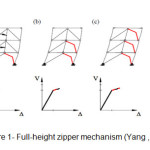 |
Figure1: Full-height zipper mechanism (Yang , 2006) Click here to View figure |
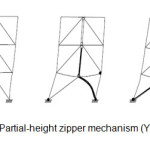 |
Figure2: Partial-height zipper mechanism (Yang , 2006) |
Because the primary function of the suspended zipper columns is to bear tension forces and suspended zipper columns support the beam at the mid span, the beam can be designed to be flexible. This results in significant savings in materials and costs in ZBF(Leon et al., 2003).
Furthermore, the force path is so clear that a capacity design for all structural members is straight forward. Moreover, by the increase in story numbers, the forces which carried out by the hat truss increase. In other words, the cross section of the hat truss became very large. As a result, the suspended zipper braced frame is limited by the number of stories (Chen et al., 2012).
The configuration and expected behavior of suspended zipper frame is shown in figure 3.
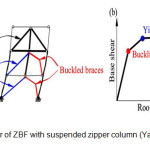 |
Figure3: Behavior of ZBF with suspended zipper column (Yang et al., 2008) |
The purpose of this research is to investigate the behavior of zipper braced frames with partial-height zipper mechanism. For this purpose, a nonlinear time history analysis was conducted on SZBF with different number of stories.
Analytical Model
To evaluate the seismic behavior of ZBF, at first the experimental frame at Georgia Tech University was verified in ABAQUS. The test frame is shown in figure 4. The member sizes for this frame are tabulated in table 1[1, (Yang et al., 2008)].
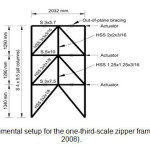 |
Figure4: Experimental setup for the one-third-scale zipper frame (Yang et al., 2008). |
Table1: Member sizes of the 1/3-scale zipper-braced frame model (Yang , 2006).
| Story | Brace | Column | Beam | Zipper column |
| 3 | HSS3x3x3/16 | S 4x9.5 | S 3x5.7 | HSS2x2x3/16 |
| 2 | HSS2x2x1/8 | S 4x9.5 | S 5x10 | HSS1.25x1.25x3/16 |
| 1 | HSS2x2x1/8 | S 4x9.5 | S 3x7.5 |
The pushover test was performed at Structural Engineering Laboratory at Georgia Tech University. Figure 5 shows the three time histories of floor displacements which were imposed at the floor level of the test frame. The results of analytical and experimental models are presented in figure 6 (Yang , 2006).
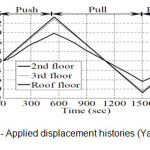 |
Figure5: Applied displacement histories (Yang , 2006) |
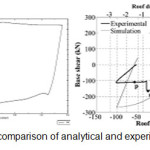 |
Figure6: comparison of analytical and experimental results |
To evaluate seismic behavior of ZBF, four models with 3, 6, 9 and 12-story frames with a bay length of 9 meter were designed using the " AISC load and Resistance Factor Design" and the "Seismic Provision for Structural Steel Buildings". The plans of the structures are presented in figure 7. The height of stories is assumed to be 3.9 m in all models. The used loads are presented in table 2.
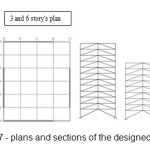 |
Figure7: plans and sections of the designed structures Click here to View figure |
Table2: imposed gravitational and live loads
| Roof story(KN/m) | Other stories(KN/m) | |
| Gravitational load | 4.1 | 4.75 |
| Live load | 1 | 1 |
The earthquake design base shear was obtained based on the minimum design load for building and other structures (ASCE7-05) setting the following parameter: occupancy importance factor=1.5 (category IV), soil type D (hard soil), over strength factor=2.0 and response modification factors=6.
The brace as well as zipper columns in the ZBF model were assumed to be made of ASTM A500 Grade B steel (Fy=317 MPa) and the rest of the members were assumed to be constructed of ASTM A572 Grade 50 steel (Fy= 345 MPa). The combination of dead load and 20% of live load was used to estimate the vibrational mass of the models. It is assumed all the joints are pinned. To reduce the computational efforts and time, a two dimensional model was used. The nonlinear time history analysis consisted of a suite of 4 and 3 ground motions, representative of 10%- in 50-year and 2% in 50- year probability of exceedence. The site properties of the ground motions are similar to those of that in the design models. The used ground motions and the corresponding properties are given in table 3.
Table3: Properties of seismic ground motions used in the analyses
| Earthquake | Station | PGA(cm/s) | Distance |
| NF13(10% in 50-year) | Nothridge, 1994, Rinaldi | 872.72 | 7.5 |
| NF14(10% in 50-year) | Nothridge, 1994, Rinaldi | 381.03 | 7.5 |
| NF15(10% in 50-year) | Nothridge, 1994, Olive View | 718.16 | 6.4 |
| LA21(2% in 50-year) | Kobe 1995 | 1258 | 3.4 |
| LA23(2% in 50-year) | Loma Prieta 1989 | 409.95 | 3.5 |
| LA31(2% in 50-year) | Elysian Park (simulated) | 1271.2 | 17.5 |
Results and Discussions
The effects of using zipper elements on low-, mid- and high-rise zipper-braced frames were studied in this section. The models described above were used to investigate the performance of the zipper braced frames by means of nonlinear time history analysis using ABAQUS program. The residual drift of roof story and max residual drift of other stories are presented in figure 9. The maximum residual drift for roof and other stories occurred under LA31 record for 9-story model and under LA21 record for 12-story model, respectively.
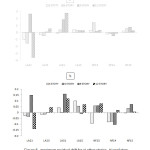 |
Figure8: maximum residual drift for a) other stories b) roof story |
The distribution of the maximum inter-story drift ratio on the frame's height is the important factor of the structure performance (figure 9). The distribution of the inter-story drift ratio is uniform over the frame's height, this means that zipper columns help to improve the performance of the structure. However, as the building height increase, larger axial force is triggered in zipper columns at the top stories and there are increases in top stories inter story drift ratios as a result of higher modes effect.
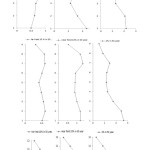 |
Figure9: Inter story drift ratio |
Conclusion
Considering all results and performed investigations, following conclusion can be achieved:
- The zipper column upgrades the performance of chevron braced frame.
- In the zipper braced frame the difference between story drift is not considerable. In other words, in zipper braced frames the distribution of the lateral displacement is uniform along the building's height.
- In the zipper braced frame, all the braces take part in seismic energy dissipation and better damage distribution was achieved.
- As the number of the stories increases, the zipper braced frame becomes a consirvative system due to higher modes effects.
- The suspended zipper frames seem to reduce the tendency of chevron braced frames to form soft story mechnism and to improve seismic performance without having to use overly stiff beams (Leon et al., 2003),(Irani Sarand et al., 2013).
References
- Yang, C., Analytical and Experimental Study of Concentrically Braced Frames with Zipper Struts. PHD Thesis (Georgia Institute of Technology, 2006).
- Khatib, I.F. Mahin, S.A. and Pister, K.S., Seismic Behavior of Concentrically Braced Steel Frames. (Earthquake engineering research center, University of California, 1988).
- Leon, R., and Yang, C., Special Inverted-v-braced Frames with Suspended Zipper Struts. International workshop on steel and concrete composite construction, October 8-9, Taipei (2003).
- Chen, Z., Seismic Response of High-rise Zipper Braced Frame Structures with Outrigger Trusses. Master Thesis (Department of Building, Civil & Environmental Engineering, Concordia University, 2012)
- Yang, C. S., Leon, R. and DesRoches, R., Design and Behavior of Zipper-braced Frames. Engineering Structures, 30 (4), 1092-1100 (2008).
- Yang, C.S., Leon R.T. and DesRoches R., Pushover Response of a Braced Frame with Suspended Zipper Struts. Journal of Structural Engineering, 134(10), 1619-1626 (2008).
- Yang, C.S. Leon R.T. and DesRoches R., Cyclic Behavior of Zipper-braced Frames. Earthquake Spectra, 26 (2), 561–582 (2010).
- Irani Sarand, N. Jalali, A. Hosseinzadeh, Y., Seismic Behavior of Zipper Braced Frames; A Review. J. Basic. Appl. Sci. Res., 3 (5), 415-419 (2013).






